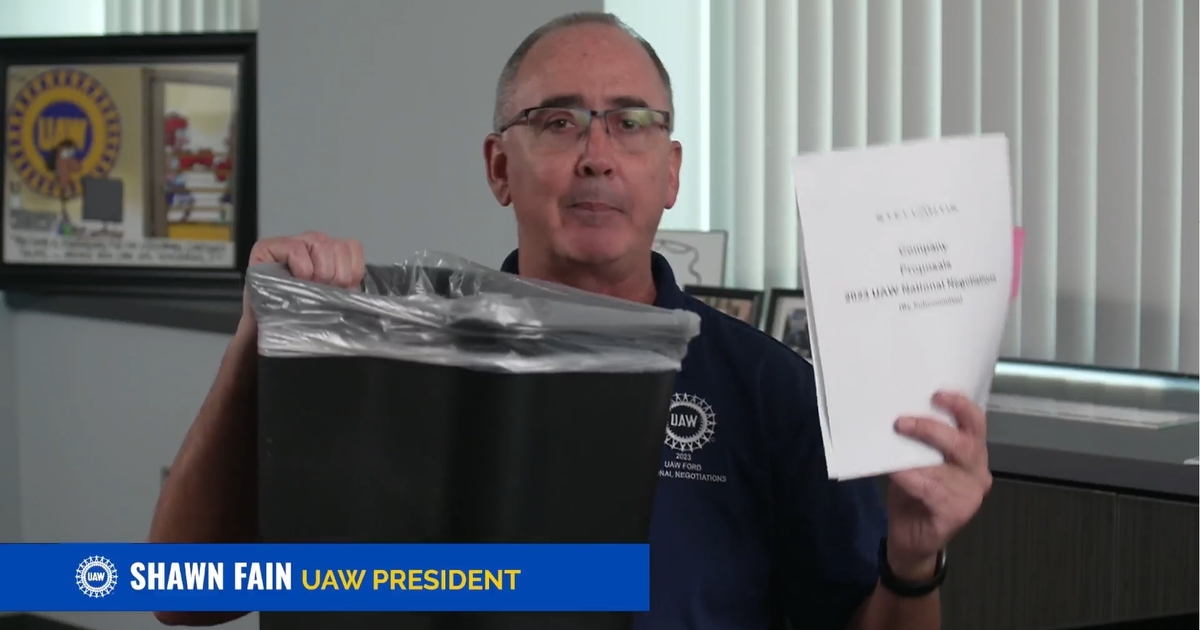
With a month to go before contracts expire for nearly 150,000 UAW-represented Detroit 3 workers, divisions appear to be deepening between the two sides on most major issues.
UAW President Shawn Fain dramatically threw a copy of proposals from Stellantis into a trash can on a livestream last week, saying the company “spit in the face” of members by seeking stricter attendance rules, reduced health-care coverage and other concessions.
But the union’s economic demands would increase Detroit 3 labor costs by up to $80 billion, according to sources familiar with the companies’ economics, an unsustainable amount that would threaten their future viability.
The UAW is not backing down. Fain appeared on social media with U.S. Sen. Bernie Sanders to rail against automaker profits and CEO compensation — two proof points he says mean they can afford the union’s demands. Fain has threatened a strike, potentially against all three companies at once, should the automakers not reward workers with “record contracts.”
“The initial contract proposals exchanged between Stellantis and the UAW do not bode well for a quick deal,” said Art Wheaton, a labor expert at Cornell University. “There appears to be a gap the size of the Grand Canyon.”
Stellantis, Ford Motor Co. and General Motors have said they are looking to make their costs competitive with non-unionized automakers so they can continue to fund costly investments in electric vehicles.
“We would not be surprised if the current labor negotiations between the Detroit 3 and the UAW prove particularly challenging,” analysts at DBRS Morningstar wrote in an investor note. They did not rule out the possibility of a prolonged work stoppage but said costs for the Detroit 3 could be manageable should a strike last less than two months.
In a particularly transparent spectacle, Fain read verbatim from a list of early contract proposals presented by Stellantis before tossing them in the garbage. Stellantis’ North American COO Mark Stewart said he was “incredibly disappointed” by Fain’s response.
“The theatrics and personal insults will not help us reach an agreement that continues our proud history of providing good wages and benefits to our employees and maintaining Stellantis’ ability to be competitive in the market,” Stewart wrote in a letter to employees. “These negotiations are critical and require cool heads and a focus on reality from everyone involved.”
The proposals call for eliminating caps on the use of temporary workers, making members work longer before receiving their full allotment of paid vacation time, increasing absenteeism penalties and gaining the ability to “demand further concessions during the life of the contract” without a membership vote.
The Stellantis proposal, a copy of which was obtained by Automotive News, says absentee workers cost the company $217 million in 2021 and 2022 by eliminating 16,706 units of production. The absenteeism rate in 2022 was 23 percent, the document said.
Stellantis’ proposals include creating a no-fault, points-based attendance system and modifying the discipline process.
The document says company health-care costs are expected to increase by $613 million over the next four years, topping $1.1 billion by 2027. Stellantis proposed an employee cost-share through deductibles, copays and out-of-pocket maximums on its medical and prescription plans, but it did not specify what percentage of costs it wants workers to pay.
“The contract currently being proposed by Stellantis would deepen the divisions in our workplace, not eliminate them,” Fain said on the livestream. “Stellantis’ proposals are a slap in the face; they’re an insult to our members’ hard work over the last four years.”
The UAW’s list of contract demands — including more than 40 percent raises for members — would increase labor costs for the Detroit 3 by $45 billion to $80 billion a year, sources told Automotive News.
Granting them would nearly triple labor rates to more than $150 an hour per employee at all three companies, the sources said.
Colin Langan, an analyst with Wells Fargo, estimated that the demands would cost each company $6 billion to $8 billion a year, raising labor costs to roughly $136 an hour per employee.
“Those costs would be unsustainable,” said Marick Masters, a business professor at Wayne State University in Detroit who specializes in labor issues. “They could not remain competitive at that level.”
Ford, GM and Stellantis today spend at least $63 an hour on each worker’s wages and benefits vs. $55 at the transplant automakers that use nonunion labor.
Hourly labor costs for Tesla Inc. are believed to be even lower, between $45 and $50 per hour.
Labor cost figures comprise multiple expenses, not all of which go into employee take-home pay, including overtime, shift premiums, profit sharing and pension payments.
Still, labor experts say such an increase is unrealistic, despite Fain’s insistence that the union is sincere about achieving everything on its list.
“You should take those estimates with a grain of salt,” Wheaton said. “You won’t realistically achieve all of those demands. Both sides have extreme initial offers that will not pass. That’s why you bargain.”

